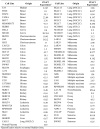PLAC1, a trophoblast-specific cell surface protein, is expressed in a range of human tumors and elicits spontaneous antibody responses
- PMID: 17983203
- PMCID: PMC2935750
PLAC1, a trophoblast-specific cell surface protein, is expressed in a range of human tumors and elicits spontaneous antibody responses
Abstract
Identification of genes that are upregulated in tumors, and whose normal expression excludes adult somatic tissues but includes germline and/or embryonic tissues, has resulted in a rich variety of cancer antigens that are attractive targets for cancer vaccine and other therapeutic approaches. In the present study, we extended this approach to include genes strongly and restrictively expressed in the placenta by mining publicly available SAGE and EST databases. We identified a number of genes with high expression in placenta and different cancer types but with relatively restricted expression in normal tissues. The gene with the most distinctive expression pattern was found to be PLAC1, which encodes a putative cell surface protein that is highly expressed in placenta, testis, cancer cell lines and lung tumors. Hence we have designated it CT92. We found by ELISA that PLAC1 is immunogenic in a subset of cancer patients and healthy women. Its physical and expression characteristics render it a potential target for both active and passive cancer immunotherapeutic strategies.
Figures
Comment in
-
Cancer is a somatic cell pregnancy.Cancer Immun. 2007 Nov 6;7:19. Cancer Immun. 2007. PMID: 17983204 Free PMC article. No abstract available.
Similar articles
-
PLAC1: biology and potential application in cancer immunotherapy.Cancer Immunol Immunother. 2019 Jul;68(7):1039-1058. doi: 10.1007/s00262-019-02350-8. Epub 2019 Jun 5. Cancer Immunol Immunother. 2019. PMID: 31165204 Free PMC article. Review.
-
Expression and serum immunoreactivity of developmentally restricted differentiation antigens in epithelial ovarian cancer.Cancer Immun. 2009 Aug 26;9:6. Cancer Immun. 2009. PMID: 19705800 Free PMC article.
-
Plac1 is a tumor-specific antigen capable of eliciting spontaneous antibody responses in human cancer patients.Int J Cancer. 2008 May 1;122(9):2038-43. doi: 10.1002/ijc.23341. Int J Cancer. 2008. PMID: 18183594
-
Cancer is a somatic cell pregnancy.Cancer Immun. 2007 Nov 6;7:19. Cancer Immun. 2007. PMID: 17983204 Free PMC article. No abstract available.
-
PLAC1 (Placenta-specific 1): a novel, X-linked gene with roles in reproductive and cancer biology.Prenat Diagn. 2010 Jun;30(6):497-502. doi: 10.1002/pd.2506. Prenat Diagn. 2010. PMID: 20509147 Free PMC article. Review.
Cited by
-
PLAC1: biology and potential application in cancer immunotherapy.Cancer Immunol Immunother. 2019 Jul;68(7):1039-1058. doi: 10.1007/s00262-019-02350-8. Epub 2019 Jun 5. Cancer Immunol Immunother. 2019. PMID: 31165204 Free PMC article. Review.
-
Placenta: an old organ with new functions.Front Immunol. 2024 Apr 19;15:1385762. doi: 10.3389/fimmu.2024.1385762. eCollection 2024. Front Immunol. 2024. PMID: 38707901 Free PMC article. Review.
-
PLAC1 affects cell to cell communication by interacting with the desmosome complex.Placenta. 2021 Jul;110:39-45. doi: 10.1016/j.placenta.2021.06.001. Epub 2021 Jun 6. Placenta. 2021. PMID: 34118612 Free PMC article.
-
The role of pregnancy associated plasma protein-A in triple negative breast cancer: a promising target for achieving clinical benefits.J Biomed Sci. 2024 Feb 23;31(1):23. doi: 10.1186/s12929-024-01012-x. J Biomed Sci. 2024. PMID: 38395880 Free PMC article. Review.
-
CAR T-Cell Cancer Therapy Targeting Surface Cancer/Testis Antigens.Front Immunol. 2020 Sep 2;11:1568. doi: 10.3389/fimmu.2020.01568. eCollection 2020. Front Immunol. 2020. PMID: 32983080 Free PMC article. Review. No abstract available.
References
-
- Wilczynski JR. Cancer and pregnancy share similar mechanisms of immunological escape. Chemotherapy. 2006;52:107–110. - PubMed
-
- Rama S, Suresh Y, Rao AJ. Regulation of telomerase during human placental differentiation: a role for TGFbeta1. Mol Cell Endocrinol. 2001;182:233–248. - PubMed
-
- Weier JF, Weier HU, Jung CJ, Gormley M, Zhou Y, Chu LW, Genbacev O, Wright AA, Fisher SJ. Human cytotrophoblasts acquire aneuploidies as they differentiate to an invasive phenotype. Dev Biol. 2005;279:420–432. - PubMed
Publication types
MeSH terms
Substances
LinkOut - more resources
Full Text Sources
Other Literature Sources
Research Materials








